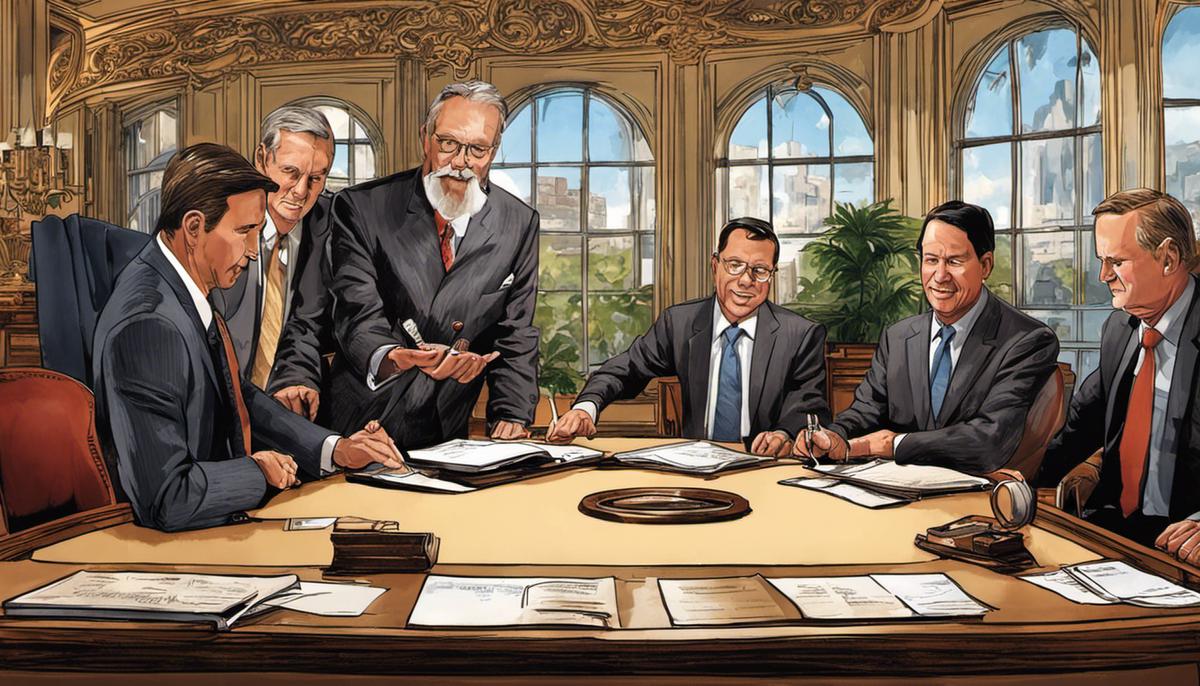In the gripping world of negotiation, few names stand out as prominently as Chris Voss. Famed as the former lead international kidnapping negotiator for the Federal Bureau of Investigation (FBI), Voss’ unique and highly effective negotiation methods have long been admired and adopted by professionals from diverse fields. This exploration will delve into Voss’ background, positioning readers for an in-depth understanding of the principles and techniques he developed through high-stake situations. By dissecting Voss’ techniques and applying them to everyday business and personal scenarios, this discourse aims to equip readers with a comprehensive grasp of Voss’ negotiation strategies and their application.
Understanding Chris Voss’ Background
Chris Voss: An Introduction to His Background
To understand Chris Voss’ negotiation techniques, it is essential to delve into his background. Chris Voss is not just any professional negotiator; he is a former FBI lead international kidnapping negotiator, a role that involved life-or-death negotiation situations. Voss was part of the Bureau’s elite Crisis Negotiation Unit for several years, where he was involved in high-stakes negotiations that tested his skills and expertise in the field. He dealt with bank robbers, terrorists, and even inmates, honing his talent in the process.
Experience as an FBI Hostage Negotiator
Possessing over two decades with the FBI, Voss’ real-world negotiation experience is extensive and varied. He was extensively involved in more than 150 international hostage cases, dealing with high-stress and pressure-filled situations. This vast experience provided Voss with unique insights into the psychology and dynamics of negotiation. As a hostage negotiator, Voss had to quickly establish rapport with kidnappers, understand their demands, and negotiate to save lives, offering an increased level of credibility to his teachings.
Influence of His Experiences on His Approach to Negotiation
Voss’ on-the-ground experience on an international level heavily influences his approach to negotiation. He relies heavily on the use of empathy, tactical empathy as he often refers, to gain the trust of the other party. His approach shifts negotiation from a competitive win-lose situation to a collaborative process where understanding the other party’s emotions, needs, and fears are central. This focus on emotional intelligence and understanding stems from his career in the FBI, where managing emotions was a crucial part of ensuring successful negotiation outcomes.
Career Post-FBI and Promoting His Philosophy
After retiring from the FBI, Voss began a new chapter in his career to share his profound knowledge and negotiation skills with the rest of the world. He founded The Black Swan Group, a consulting company that trains individuals and businesses in his negotiation techniques and strategies. He also authored the book “Never Split the Difference: Negotiating as if Your Life Depended On It,” where he presents his core philosophies and imparts practical negotiation advice based on his real-world experiences.
Not Just About Negotiation: A Personal Philosophy
Voss’ approach to negotiation transcends into a personal philosophy as well. He believes that being successful in negotiation means also being successful in life. The ability to communicate effectively, listen empathically, and connect on a deeper emotional level are skills that people can apply in their personal lives to build stronger and more meaningful relationships.
The phenomenal experience Chris Voss has gained from being an FBI hostage negotiator has shaped his negotiation approach. This approach puts a spotlight on empathetic communication, emotional intelligence, and forging strong relationships, which he believes are pivotal for successful negotiations. Grasping his personal experiences and background will enhance a professional’s understanding of Voss’s groundbreaking and impactful negotiation strategy.
Voss’ Negotiation Techniques
Introduction to the Negotiation Techniques of Chris Voss
Former FBI negotiator, Chris Voss, has devised a series of negotiation techniques that prove to be impactful not only in his line of work such as law enforcement but also in common life scenarios including personal and business transactions. The mainstay techniques that he recommends include “Mirroring”, “Labeling Emotion”, and viewing “No” as the commencement instead of the conclusion of a negotiation discussion.
The Mirroring Technique
The mirroring technique is one of Voss’ most recognized negotiation strategies. Mirroring involves repeating the last few words or main idea of what someone just said. The purpose is to elicit more information or create a sense of rapport. When done correctly, the other person might feel as if you’re really understanding them, prompting them to elaborate more on their thought process, which can ultimately lead to better negotiation outcomes.
Labeling Emotion
‘Labeling Emotion’ is another technique used by Voss to defuse potentially volatile situations and create empathy. By verbalizing the emotions that the other party might be experiencing, it not only shows understanding and empathy, but also often leads to the other party agreeing or providing more detail. These labels typically start with phrases such as “It seems like you’re…” or “It sounds like you’re…”. This validation can earn their trust and makes them more willing to negotiate.
‘No’ as a Start
Voss recommends treating a ‘No’ not as a roadblock but rather the starting point in a negotiation. A ‘No’ could mean the other party feels uncomfortable, they don’t understand, or they need something else. By embracing ‘No’ instead of avoiding it, negotiators can use questions and statements to determine the reason behind the ‘No’ and pivot from there. This technique holds the potential to transform negative responses into vehicles for furthering conversation and progressing the negotiation.
Unpacking Voss Negotiation Techniques
Exceptional negotiator, Chris Voss, emphasizes the importance of tactical pauses and open-ended questioning during the negotiation process. He argues that by asking strategic questions and allowing for silence in the conversation, negotiators can glean critical information from the other party without the need for explicit interrogation. His best-selling book, “Never Split the Difference,” provides a deep exploration of many such negotiation techniques, all derived from his successful career in crisis and high-pressure negotiations.

Application of Voss’ Technique in Business and Personal Scenarios
Chris Voss’ Negotiation Strategies: Revolutionizing Business Negotiations
As a former FBI hostage negotiator, Chris Voss developed a unique set of negotiation strategies. These principles have been game-changers in managing complex hostage situations and are now revolutionizing how businesses handle agreements and high-stake deals.
Central to Voss’s method is the skilled employment of empathy to influence both the discussion and its outcome. This approach is especially beneficial in business negotiations, as it involves a deep understanding of the other party’s needs and objectives. For instance, when discussing contracts, prices, or terms of agreements, businesses can foster trust and promote transparent conversations by recognizing the other party’s point of view and addressing their needs. This ultimately leads to a satisfying agreement that benefits all parties involved.
Voss’ Techniques: Effective Handles for Personal Negotiation Scenarios
Personal negotiations, which frequently involve a degree of emotional investment, presents a different set of challenges. Fortunately, Voss’ principles are flexible and adaptable. His ‘Labeling’ technique, for example, is designed to validate the counterparty’s feelings in a way that helps redirect emotions in a constructive way. Whether it’s negotiating with a child about bedtime or resolving a dispute with a neighbor, displaying understanding and compassion builds rapport, thereby increasing the likelihood of a satisfactory resolution.
The Powerful ‘Mirroring’ Technique in Business and Personal Negotiations
One of the most effective tools in Voss’ negotiation toolkit is called ‘Mirroring.’ This technique works by repeating the last few words of the speaker’s statement, which encourages them to elaborate further. In a business situation, this could be used during a client meeting to gain more insight, promoting a deeper understanding and therefore framing a better proposal. Similarly, in a personal context, it could be used to diffuse a tense situation or to gain a deeper understanding of a loved one’s concerns.
Voss’ ‘No’ Oriented Approach: Shaking Up Traditional Negotiation Tactics
Traditional negotiation strategies often focus on leading the conversation towards a ‘yes.’ However, Voss revolutionized this approach by revealing that ‘no’ can often be more powerful. In a business negotiation, this technique allows the other party to feel in control whilst shielding your objectives. Similarly, when used in a personal context, this approach prevents the negotiation from being one-sided, instead creating a balanced dialogue that respects the autonomy of both parties.
Adapting the ‘Calibrated Questions’ Technique for Business and Personal Success
‘Calibrated questions’ is another skill in Voss’ negotiation strategy that promotes active collaboration. These questions are designed to make the other person feel like they’re in control while guiding them to your desired outcome. In a business scenario, this could mean strategically asking a prospective client about their ongoing challenges, leading them to realize the value of your product or service. Similarly, in personal negotiations, understanding the other person’s point of view by asking calibrated questions can lead to a more fair and agreeable compromise.
Mastering ‘Tactical Empathy’ in Voss’ Negotiation Approach
The concept of ‘tactical empathy’ stands as a cornerstone in Chris Voss’ negotiation strategy. This approach provides all parties in a negotiation scenario the feeling of being acknowledged and understood. In the realm of business, implementing ‘tactical empathy’ can aid in cultivating enriched, nuanced relationships with clients, partners, or employees, simultaneously steering towards the benchmarked goals. On a personal front, it assists in creating deeper connections and reciprocated respect while managing conflicts or disagreements.

Critiques and Limitations of Voss’ Techniques
Exploring Ethical Concerns of Utilizing Empathy in Voss’s Techniques
Despite the apparent importance of ‘tactical empathy’ in Chris Voss’ negotiation protocols, there exists some controversy around its implementation. Critics question the line between empathy as a communication tool and empathy as a means of subtle manipulation. While Voss persistently emphasizes the essence of understanding the feelings and viewpoints of the opponent, certain critics suggest that this strategic mastery of empathy might potentially unroll into an unethical practice of manipulation, tacticly used to skew the negotiation in favor of one party’s own interests or gains.
Potential Limitations of the “Mirroring” Technique
Voss’ “mirroring” technique, where you repeat the last few words a negotiator has said to prompt them to continue speaking, has been pointed out as having its limitations. The effectiveness of this technique relies on the willingness of the counterparty to further elaborate. In situations where the other party may be uncommunicative or defensive, this technique may not work at all and might even lead to frustration or misunderstanding.
The Risk of Overcomplicating Negotiations
Voss’ negotiation approach could also be considered complex and difficult to master, presenting a potential limitation. With elements like tactical empathy, mirroring, labeling, calibration questions, and the “accusation audit”, there’s a danger of overcomplicating a negotiation rather than simplifying it. This level of complexity requires not only thorough understanding, but also continuous practice and adaptation according to the situation, which could be daunting for beginners in the field.
Power Dynamics and the ‘Dark Sides’
A further critique of Voss’s techniques arises when considering power dynamics. While Voss’ FBI background and experiences in high-stakes negotiations provide impressive credentials, critics suggest that his techniques may not be as applicable in everyday, low-stakes negotiations. Voss’ methods also risk being employed irresponsibly. They were originally designed for high-stakes hostage scenarios where lives were at risk, and could possibly have darker connotations when applied to corporate negotiations.
Dependency on Emotional Intelligence
Another critique lies in the implicit assumption in Voss’ techniques that negotiators have a high level of emotional intelligence. The ability to read and respond to counterpart’s emotions effectively and ethically forms a crucial part of Voss’ approach. If a negotiator lacks such emotional intelligence, applying these techniques might prove not only ineffective, but potentially harmful as they might misinterpret emotional cues, leading to misinformation and misunderstanding.
While Chris Voss’ negotiation techniques have been widely recognized for their effectiveness, these critiques and limitations caution us to consider potential drawbacks. It’s important to situate his strategies within the wider negotiation theory and practice, evaluating their applicability in varied contexts.

Key Takeaways and Implementation
Delving into Chris Voss’ Negotiation Strategies
A renowned figure in this field, Chris Voss, is a former FBI hostage negotiator known for his transformative approach to negotiations. His model revolves around the concept of tactical empathy, which is the capacity to resonate with others’ emotions while maintaining strategic poise. This method, etched in his seminal work “Never Split the Difference”, serves as a guide for understanding his unique negotiation techniques.
Key Takeaways from Voss’ Negotiation Techniques
- Embrace Tactical Empathy: According to Voss, empathy lets your counterpart know that you are aware of their emotion and can respect their feelings. This creates a rapport and humanizes the negotiation process.
- Master the Mirroring Technique: This involves mimicking the other person’s words, which prompts them to explain their thoughts further, thus providing more information that could be beneficial to you.
- Use Open-Ended Questions: Using ‘How’ or ‘What’ questions allows your negotiation partner to share more details. It puts them in control, making them more likely to collaborate.
- Silence is Golden: Maintaining silence at the right times can be fruitful. It allows your opponent to fill the silence, often revealing more than they intended to.
- Bargaining is an Art: Instead of splitting the difference, Voss argues for learning the art of bargaining, which often leads to better outcomes for both parties.
Implementing Voss’ Negotiation Techniques
To implement these techniques in your negotiations, make the following actionable steps part of your routine:
- Adapt a Collaborative Mindset: Treat negotiations as a collaborative problem-solving exercise rather than a battle to be won. This shift in mindset opens up the possibility for creative solutions and negotiation longevity.
- Practice Tactical Empathy: The ability to understand and validate the other party’s perspective is crucial. This can be done by actively listening, mirroring their language, and acknowledging their feelings and perspectives.
- Mastering the Skill of Mirroring: Start by practicing the mirroring technique in daily conversations. This practice can help you become adept at this skill, where you mirror the last few words the other person said or paraphrase their message to encourage them to expand their thinking.
- Leverage Open-Ended Questions and Silence: Use open-ended questions in your negotiations and give the other party time to respond. Staying silent can be uncomfortable, but if done right, it could lead to your counterpart filling in the information gaps, offering valuable insights.
- Learn the Art of Bargaining: Perfecting negotiation requires practice. Start small, possibly with day-to-day negotiations, and learn to identify anchor points, create a range, and develop multiple offers to better navigate your way in critical negotiations.
In a nutshell, implementing Voss’ negotiation techniques is an approach that does not treat negotiation as an act of war, but rather as a process of discovery. The aim here is to uncover as much information as possible to collaborate and reach mutually beneficial solutions. This not only leads to optimal business outcomes but also builds lasting relationships.
Unpacking Chris Voss’ negotiation strategies offers a profound understanding of his effective negotiation tactics, providing us with tools that are applicable in the corporate world, personal relationships, and beyond. While these techniques have limitations and may not be universally applicable, the understanding and adoption of these strategies can give one a discernible advantage in a wide array of negotiation settings. Being aware of cues, maneuvering conversations towards a desired outcome, and fostering collaboration even in conflict-laden scenarios form the essence of Voss’ negotiation approach. By incorporating these techniques into your negotiation arsenal, you empower yourself to steer conversations, manage disputes, and ultimately, achieve your negotiation goals.
